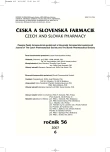-
Medical journals
- Career
Flavonoid accumulation in Scutellaria baicalensis Georgii in vitro cultures upon treatment with sodium cinnamate
Authors: J. Martin; J. Dušek
Authors‘ workplace: Charles University in Prague, Faculty of Pharmacy in Hradec Králové, Department of Pharmacognosy
Published in: Čes. slov. Farm., 2007; 56, 280-283
Category: Original Articles
Overview
The production of secondary metabolites by plant cell cultures has been suggested as a feasible technology that attracted considerable industrial and academic interest in the past three decades. However, many secondary pathways are not well expressed in plant cell cultures. Optimization of culture medium, elicitation, genetic engineering and the supply of biosynthetic precursors are among the strategies adopted to increase secondary metabolite production in vitro. In this study, the effects of five potential biosynthetic precursors on the production of baicalin and baicalein in Scutellaria baicalensis Georgii suspension and callus cultures were measured. The results of this work show that flavonoid biosynthesis was most stimulated by the addition of sodium cinnamate in the concentration of 5 mg.l⁻¹ and by cinnamic acid (1 mg.l⁻¹). Feeding with L-phenylalanine, malonic acid and sodium malonate did not induce changes in the amounts of flavonoids, and the biomass production was not affected.
Key words:
Scutellaria – skullcap – precursor – sodium cinnamate – cinnamic acid – in vitro cultures
Labels
Pharmacy Clinical pharmacology
Article was published inCzech and Slovak Pharmacy

2007 Issue 6-
All articles in this issue
- Oxycellulose – a cellulose derivative with a potential to become an active pharmaceutical substance as well as an auxiliary substance
- Physiology and pharmacology of hyaluronic acid
- A study of the properties of tablets from coprocessed dry binders composed of α-lactose monohydrate and different types of cellulose
- Experience with ciclesonide in patients with mild persistent bronchial asthma
- Flavonoid accumulation in Scutellaria baicalensis Georgii in vitro cultures upon treatment with sodium cinnamate
- Evaluation of mechanical strength of tablets from microcrystalline cellulose by means of energetic parameters
- EXPERTA – the first company specializing in scientific evaluation of medicaments
- Czech and Slovak Pharmacy
- Journal archive
- Current issue
- Online only
- About the journal
Most read in this issue- Experience with ciclesonide in patients with mild persistent bronchial asthma
- Physiology and pharmacology of hyaluronic acid
- Oxycellulose – a cellulose derivative with a potential to become an active pharmaceutical substance as well as an auxiliary substance
- A study of the properties of tablets from coprocessed dry binders composed of α-lactose monohydrate and different types of cellulose
Login#ADS_BOTTOM_SCRIPTS#Forgotten passwordEnter the email address that you registered with. We will send you instructions on how to set a new password.
- Career

